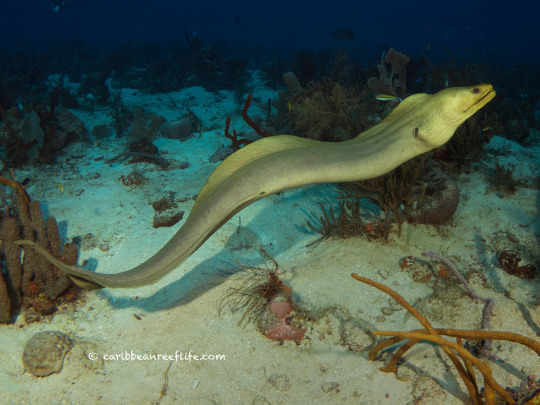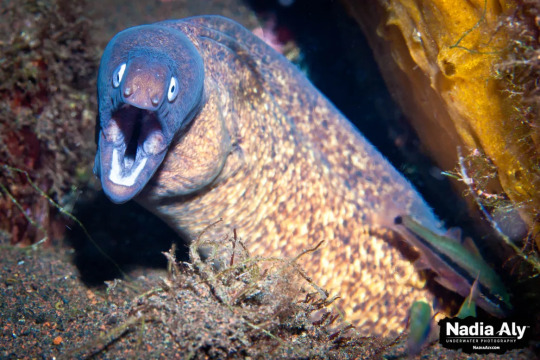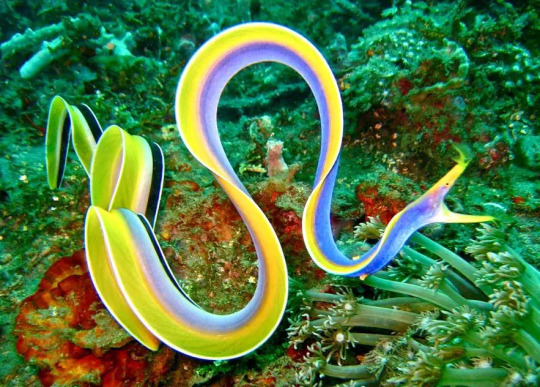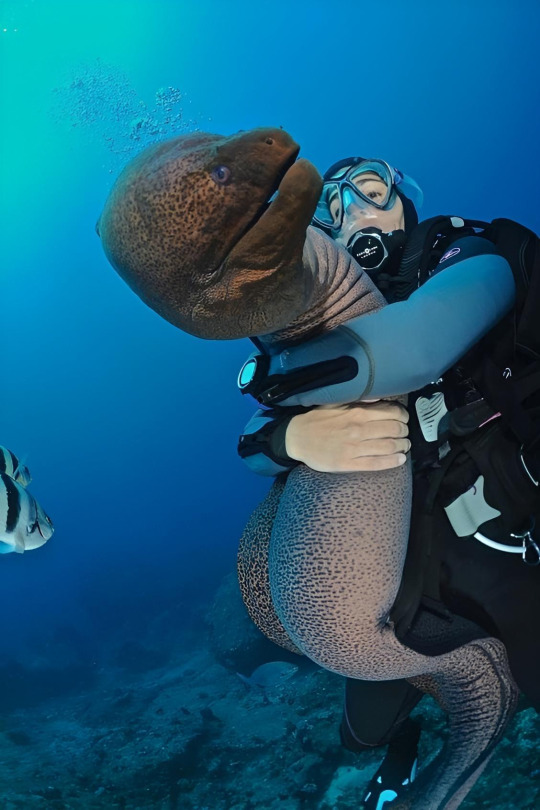#sathet
Explore tagged Tumblr posts
Text
Wet Beast Wednesday: moray eels
This week on Wet Beast Wednesday I'll be going over something amazing, a fish with a sense of morality. You see, the moral eel is known for, what... I think I'm reading this wrong. Oh, MoRAY eel, not moral. Well this is awkward. Hang tight, I need to go redo my research.

(Image: a green moray (Gymnothorax funebris) swimming outside of its burry, with its whole body visible from the side. It is a long, slender fish that looks a bit like a snake. A long fin starts just below the head and continues down the length of the body. The body is arranged in a wave pattern. It has a pointed snout and small eyes. Its body is a yellow-green color. In the background is the sandy seafloor, dotted with various sponges and corals. End ID)
Moray eels are true eels, meaning they are in the order Anguiliformes. Yeah, I did wolf eels, electric eels, and lamprey eels before I got around to actual eels. There are over 200 known species of moray eel in 15 genera. Like other eels, they are elongated bony fish with extra vertebrae and reduced fins. Moray eels have fewer fins than most eel species, only having a dorsal, anal and tail fin that merge together and run down the back of most of the body and underneath portion of it. They achieve motion by undulating this long fin and sometimes undulating the rest of the body as well. Moray eels aren't the fastest of fish, but they can swim backwards, something almost no fish can. The head has a long snout with wide jaws. Most species have long fangs used to grab onto prey, but a few species are adapted to eat hard-shelled prey and have molar-like teeth to crush through shells instead. Probably the coolest feature of morays are the pharyngeal jaws. This is a second set of jaws located in the back of the mouth. When the eel bites onto prey, the jaws can be shot forward to grab the food and help pull it into the throat. While lots of fish have pharyngeal jaws, morays are the only ones who can extend their pharyngeal jaws forward and use them to grab prey. Morays have smooth, scaleless skin that is often patterned to provide camouflage. The skin is coated in mucus that provides protection from damage and infection. In some species, the mucus can be used to glue sand together to help reinforce burrows. Morays lack lateral lines, a system of organs found in most fish that senses changes in water movement. Their sense of smell is their primary sense. The size of morays varies between species. The smallest species is the dwarf moray eel (Gymnothorax melatremus) which reaches 26 cm (10 in) long. The largest species by mass is the giant moray eel (Gymnothorax javanicus) which can reach 3 meters (10 ft) and 30 kg (66 lbs) while the longest species is the slender giant moray (Strophidon sathete), the longest known specimen of which measured in at 3.94 m (12.9 ft).

New reaction image
(Image: a giant moray (Gymnothorax javanicus) emerging from a burrow. It is brown and mottled with yellowish patches. Its head is pointed at the camera and it's mouth is wide open, aming it look shocked. End ID)

(Image: an anatomical diagram of the skeleton of a moray eel emphasizing the pharyngeal jaws and the muscle attachments. End ID. Art by Zina Deretsky)
Moray eels are found throughout the Atlantic, Pacific, and Indian oceans. Different species are found in different temperatures and depths, though most species live in relatively shallow, warm water. Several species can live in brackish water and a few will swim upriver and live for a time in fresh water, though there do not appear to be any species that live their entire lives in fresh water. Morays are ambush predators who rely on the element of surprise. They live in small, tight places such as holes in coral, gaps between rocks, or sandy burrows. When prey passes, the eel can lunge out and grab it. Unlike most fish, the eel cannot use suction feeding due to the shapes of their mouths. They have to rely on lunging froward and catching prey with their mouths. Their mouths are adapted in shape to push water to the sides. This reduces water resistance and avoids creating a wave that could push prey away from the eel. If an eel catches prey that cannot be swallowed whole, it will tie itself in a knot while biting on to the food. By pulling its head through the loop, the eel can rip the food into bite-sized pieces. Spending most of their times in burrows also provides protection from predators, especially in juveniles or smaller species. At night, the eels will come out of their burrows to hunt sleeping prey while the larger predators are asleep. Giant morays have also been seen engaging in interspecies cooperative hunting with roving coral groupers (Plectropomus pessuliferus). The eels can fit into small crevices the groupers can't to flush prey into the grouper's path while catching their own. Morays are mostly solitary species and many can be territorial. They are known to be shy and will retreat into their burrows if they feel threatened. They are also curious and many species are quite intelligent.

(Image: a male ribbon eel (Rhinomuraena quaesita) on a coral reef. It is a very long and slender eel with its body curved in many waves. It is brightly colored, with a blue-purple body, yellow fin and face, and a long black and white stripe running down the back half of the body. On the nostrils are two feather-like structures. End ID)
Morays reproductive strategies are poorly known and differ based on species. While many species seem to have no set mating season and will reproduce whenever they can, others will mate at the same time every year. Some species seem to have dedicated spots to lay their eggs and a few are believed to be anadromous, meaning they travel from the sea to fresh water to spawn. Meanwhile, some of the species that spend a lot of time in fresh water are catadromous, meaning they return to sea to mate. Females will lay their eggs and the male fertilize them. After this, they depart, providing no parental care. As with all true eels, moray eels begin life as leptocephalus larvae. This type of fish larvae is notable for its resemblance to a simple, transparent leaf with a head on one end. These larvae are unique and poorly understood, despite being the larval stage of a lot of different species of fish. They are unusually well developed for larvae, capable of active swimming and generally living life. In fact, some particularly large leptocephalus larvae were initially mistaken for adult fish. They feed mostly on bits of drifting organic material called marine snow and can remain in the larval stage for up to 3 years, with those in colder conditions usually taking longer to metamorphose. All leptocephalus larvae start out with no sex organs, then develop female organs, then develop male ones, becoming simultaneous hermaphrodites. They will ultimately become eith male or female and it is likely that environmental factors are the main determining factor. During metamorphosis into a juvenile, the leptocephalus can reduce in size by up to 90%, resulting in the juvenile being smaller than the larva. The process of maturation is poorly understood, but it seems that most morays will be sexually mature by three years of age.

(Image: multiple photos of a particularly large leptocephalus larva (not sure what species). It is a translucent organis, wth a body shaped like a very long leaf, narrow at both ends. In the frint is a very tiny head. End ID)
Morays are shy and generally avoid humans. Though some cultures have hunted them for food, they are often not considered a particularly good food source. Many species have high levels of chemicals called ciguatoxins in their bodies, which can lead to a condition called ciguatera fish poisoning if eaten. The largest threat to morays is habitat loss. This is especially true for the many species that live in coral reefs, which are in increasing danger due to global warming. Attacks on humans are rare and usually happen as a response to a human sticking their hand in the eel's burrow. Some of the large species could cause significant damage with a bite. Some species, usually the smaller ones, are found in the aquarium trade, thought they are not good pets for beginners as even the smallest morays are still large for aquarium fish and have some specific requirements. The curiosity many morays have has led to some becoming familiar with and even friendly to humans, often the result of feeding them. They can recognize individual humans and remember them over the course of years. Aquarium employees sometimes report that the eels will come to nuzzle and play with them and have personalities like dogs. Marine biologists and professional SCUBA divers Ron and Valorie Taylor befriended a pair of eels they named Harry and Fang at the Great Barrier Reef who would remember them and come out to visit them year after year.

(Image: a SCUBA diver hugging a large, brown moray with black spots. End ID)
youtube
(Video: A shot video showing Valeria Taylor and a moray eel she befriended)
youtube
(Video: the song "That's a Moray", a parody of the song "That's Amore" by Dean Martin)
#wet beast wednesday#i accidentally typed moron eel more than once#moray eel#eel#anguiliformes#fish#bony fish#fishblr#fishposting#eelposting#marine biology#biology#ecology#zoology#animal facts#informative#image described#that's a moray#educational#Youtube
1K notes
·
View notes
Text
'Freshwater' moray eels for the brackish tank
As a child I was surprised and fascinated, to meet in aquarium retailers, something I did not know existed - a freshwater moray eel. In fact confusion and misinformation surrounds the matter of freshwater and brackish morays in the aquarium trade. Fortunately the species traded, was and is almost always a well known species, specifically "Gymnothorax" tile, the Indian mud moray of ichthyologists. (Gymnothorax is currently quite an unnatural grouping of muraenid, or moray eel species, as is Echidna.)
This trade labelling is unfortunate, because these eels merely visit freshwaters, and do not seem to flourish upriver, in the long term. Whereas they do well tolerate life in the low salinities of estuaries, similar to scats, monos, and the like. Fortunately the mud moray is an easy fish to care for, if only its basic requirements are met by a conscientious aquarist. Moray eels as a whole are robust aquarium denizens.
In the wild, this 60 centimeter or 24 inch long eel, inhabits the muddy river estuaries entering the Indo-West Pacific oceans. Though it may also be found in inshore seas, this eel is considered primarily a brackish water animal. In the aquarium, it unsurprisingly does fine at a salinity from 1.010 up to marine salinity, and at a temperature of 22 to 30 degrees centigrade.
These are a clumsy, predatory fish, and quite inoffensive to any tankmates too large to be recognised as prey by the eel, including similarly sized conspecifics. So a number of mud morays can safely be accommodated together, and with other fish sharing their environmental requirements.
The aquarium lighting should be dim, or if not, the eel should have access to a shaded portion of the aquarium. Decor should also facilitate such hiding behaviors, on the basis that the nature of all morays is to lurk. Feeding this carnivore is unproblematic, using items from the fishmongers, or defrosted meaty foods.
Two other morays are sometimes traded as freshwater species, but only one of them, the tiger moray ("Gymnothorax" polyuranodon) actually is. The pink lipped moray ("Echidna" rhodochilus) is a more durophagous species, consuming hard shelled prey items most moray species cannot crack open, though but contents from "Echidna" eels prove them to consume small fishes as well. This is a smaller eel than the mud moray, that grows to nearly 35 centimeters, or 14 inches in length.
The pink-lipped or white-checked moray, like the Indian mud moray, is another Indo -Pacific species found wild in brackish conditions, as well as in adjacent coastal seas, and it seems, only as a vagrant when it is encountered further upriver. For this species, parameters as suggested for the Indian mud moray should suffice, and the two species are in fact compatible tankmates. Of these two estuarine species, the pink-lipped has a reputation as bolder, but its more rarely encountered in aquariums.
At least two further moray species are recorded from estuaries, but they are not to my knowledge traded under the label of "freshwater moray eel" - the yellow spotted or "skeletor" moray ("Echidna" xanthospilos), although it is sometimes traded in the saltwater hobby, and the Gangetic moray (Strophidon sathete), which also happens to be the longest described moray species.
Despite certain species living part of their life cycle in freshwaters or estuaries, anguilliforms or true eels and their allies seem constrained to spend part of their life cycle at sea, as planktonic leptocephali, during which time they consume marine snow. Even the freshwater tiger moray, has a marine stage in its life cycle.
#freshwater moray eel#Brackish fishes#misunderstood fish#Gymnothorax tile#Indian mud moray#Pink-lipped moray#Echidna rhodochilus#aquarium eels#White-cheeked moray#oddballs
0 notes
Note
eel (pleading emoji) they're my fave pls pls pls
I've got so many eels up my sleeve u don't even know

Giant moray eel (Gymnothorax javanicus), the largest moray in terms of mass.

Slender giant moray or gangetic moray (Strophidon sathete), the largest moray in terms of length.

Dwarf moray (Gymnothorax melatremus), the smallest moray.

Goldspotted snake eel (Myrichthys ocellatus)

Shrimp eel (Ophichthus gomesii)

Spotted garden eel (Heteroconger hassi)

Sharptail snake eel (Myrichthys breviceps)
And a fun fact- electric eels in the amazon are not all one species! There are 3 recognized species as of 2019; Electrophorus electricus, Electrophorus varii, and Electrophorus voltai.
image credits: x, x, x, x, x, x, x
#boras posts#salt#moray eel#eels#fishblr#marine life#ocean life#ocean#ty for tha ask :D!!#ask#request
382 notes
·
View notes
Note
Are your bath sathets made out of hemp or jute/burlap?
Currently jute, but I would like to switch to hemp in the future!
2 notes
·
View notes
Photo

This, like Senali, is an Alternian troll, who I recently adopted from a friend, and who… needs a lot of love, to be honest. The only things that were ever entirely consistent about her were her name and her appearance, so I’m not very far on reworking her, but I’ve added everything I’ve gotten worked out so far!
Name: Murena Sathet (Murena, her new first name (changed from the old one of Moreai), is a bastardization of the first part of Muraenidae, the family moray eels are in. As for her last name, it’s taken from Strophidon sathete, the slender giant moray.)
Theme: Moray eels.
Age: 7 sweeps
Strife specibus: I’m thinking maybe something like a bear trap?
If you want a funnier weapon that echoes the moray eel’s jaws, maybe those plasticky vampire fangs that they hand out on Halloween? Should alchemize them with different stuff to make it comically larger, or maybe hold them in her hands like snappy castanets?
Fetch modus: ???
I’m tempted to do like…a modus where her captcha cards are floating by on a current and she needs the reflexes to grab the one she needs? I kinda like it from a predator perspective.
Blood color: #700053, placing her near tyrian.
Symbol and meaning: A martini glass, as per your suggestion!
Trolltag: ??? (It was originally devilishAppeaser, for reasons consisting almost entirely of sounding cool.)
My Internet is completely down as I’m writing this so I can’t do my usual strategy of “find a word and rabbithole through the etymology until you reach something related.”
I REALLY want some sorta pun on moray eel/moirail, especially because that’s a major relationship that you’ve listed. I’ve got a couple of ideas for how to pull that off, but I’ll leave it up to your discretion,
Also for whatever reason I rly wanna recommend darthMawl lol.
Quirk: Replaces c with <, intended to imitate a moray eel’s maw- in the same vein, she also capitalizes Y and V. She also tends to use trashy text speak, curses a lot, and will occasionally replace the letter after a C with a -, as if it was eaten.
Oh my god that’s so cute. I love it.
Lusus: A massive moray eel, with the sort of double-mouth thing the xenomorph from Alien had going on.
I’m literally picturing Slypher the Sky Dragon from Yu-Gi-Oh right now, minus wings. Perfect.
Personality: Murena is sort of a cruel person, though she’s nice enough to her close friends- she tends to trash talk people she dislikes, or people her friends dislike, or people in general to be perfectly honest. She’s also very shy around anyone she doesn’t know well, which she covers up by acting exactly as anyone would expect of a seadweller. She holds grudges very, very strongly, and won’t let them go until the troll who’s wronged her is dead.
Hemoloyalty: Very hemoloyal, though she’s starting to have doubts, as she’s aware that her moirail having powers despite her blood color will likely get her culled, even if her kindness doesn’t.
Honestly given that she’s higher-blooded I almost want her…not to shed her hemoloyalty? I mean maybe I’m about to divulge something very sad about my normalized experiences but we’ve all had that one friend who totally understands that you face danger from being different so maybe you could just…tone down the different? Is that really so hard to just work at not being so different? Aren’t you just making your own life harder? I mean I’ve avoided all this danger.
Important Relationships: As mentioned with Senali, they’re moirails. She’s done her best to “protect” Senali by setting traps up around her home- for her safety, of course- and by keeping her from learning anything about how likely she is to be culled for her behavior. She’s also instructed Senali not to sing when other people are around, in an effort to keep her powers from being discovered.
Yeah see what you’ve written here plays into the attitude toward downspectrum friends that I mentioned above.
Interests: Loves parties and similar social events, and will often venture into low- and midblooded cities where they exist so as to enjoy the nightlife there. She also enjoys hunting, largely with traps, and has a fondness for classical music.
Liking parties doesn’t really seem to gel with the personality mentioned? I think strike that in favor of someone who prefers small hangouts without having the gumption to set them up herself.
Dislikes: ???
Evidently, trolls down-spectrum!
Title: Seer of Time (Again, no explanation.)
‘~’ I’m gonna pass the baton to CD if ae is okay with that, because I honestly have no idea. Shot in the dark I would say maybe a Witch of Blood? It would force her to grow into a person who takes active steps to change her relationships with others, especially with Senali
Land: ???
Depends on the title.
Dream Planet: ???
I like Derse, the planet of free will over destiny.
Ancestor: ???
The Socialit, a petite mistress who threw lavish, exclusive parties. IDK I just like the idea.
Dancestor: Leucru Sathet, who has no other information as of yet.
Beforan self: ???
I think it’s difficult to flesh this part out before you set more of Murena’s character in stone.
Hive: An underwater cave, with an entrance just barely big enough for her lusus to fit through (which still makes it a good three feet wide). The area around it is trapped heavily to prevent intruders.
I assume the inside is larger to accommodate her lusus?
God, I’ve had most of I’ve written above down for such a long time, but I feel like it’s not enough? I feel like I can add more but I’ll be damned if I know what.
…Fuck it let’s go to the redesign that’s at least easier. There’s not much, but let’s do the usual top-to-bottom.

Horns – just straightened them out so they look like the sides of your symbol.
Eyes and Mouth – Moray eels have large, round eyes and thin lips with a wide jaw filled with rows of small teeth. Tried to bring that out so her design didn’t look as generic.
Shoes – there wasn’t a design reason for her to have green shoes, so I decided to change them to Senali’s color as a nod to their moirallegiance.
Anyway that’s it. I feel like this review was woefully inadequate and I’m sorry ;A;
-TR
#iceythemermaid#murena#sathet#murena sathet#violetblood#seadweller#review#redesign#tr review#submission
2 notes
·
View notes
